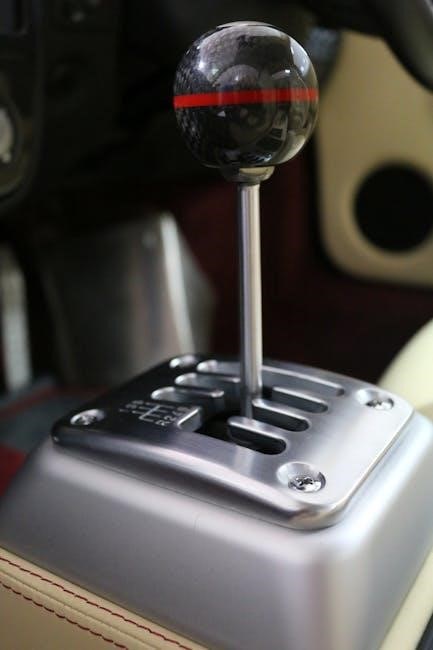The debate between paddle shifters and manual transmissions highlights a choice between modern convenience and traditional driver engagement‚ offering distinct experiences based on personal preferences and driving needs.
Overview of Paddle Shifters and Manual Transmissions
Paddle shifters and manual transmissions represent two distinct approaches to gear control‚ each catering to different driving preferences. Paddle shifters‚ mounted on the steering wheel‚ enable rapid gear changes without moving your hands‚ making them ideal for high-performance or city driving. Manual transmissions‚ involving a clutch pedal and gearshift‚ offer a more tactile and engaging experience‚ appealing to purists who enjoy a direct connection with their vehicle. While paddle shifters prioritize convenience and speed‚ manual transmissions emphasize driver engagement and control‚ making each suitable for varying driving scenarios and personal preferences.
Importance of Choosing the Right Transmission Type
Selecting the right transmission type is crucial for optimizing performance‚ comfort‚ and driving satisfaction. Paddle shifters offer convenience and quick gear changes‚ ideal for high-performance or urban driving‚ while manual transmissions provide greater control and engagement‚ appealing to enthusiasts. Choosing the wrong type may lead to dissatisfaction or reduced efficiency. Considering personal preferences‚ driving style‚ and vehicle use helps ensure the best match‚ enhancing overall driving experience.
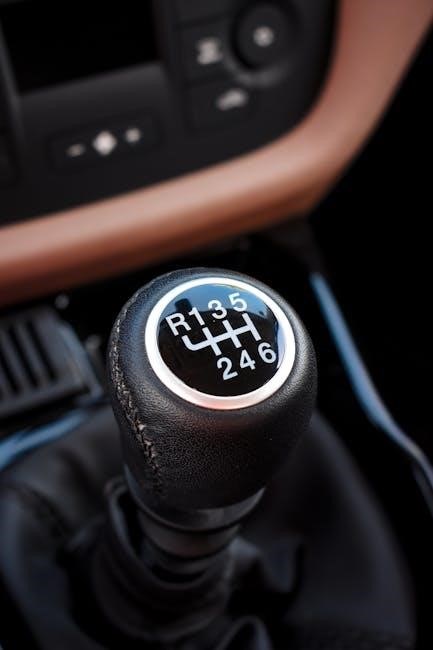
What Are Paddle Shifters?
Paddle shifters are steering wheel-mounted controls allowing drivers to manually change gears without removing hands from the wheel‚ typically paired with automatic or dual-clutch transmissions for quick shifts.
Definition and Functionality
Paddle shifters are small‚ steering wheel-mounted levers enabling drivers to manually change gears without removing their hands from the wheel. Typically paired with automatic or dual-clutch transmissions‚ they provide quick‚ precise gear transitions. The right paddle shifts up‚ while the left shifts down‚ maintaining control and focus on the road. This system combines the convenience of an automatic transmission with the driver engagement of manual shifting‚ ideal for performance driving. Paddle shifters are often equipped with features like rev-matching and automatic downshifting‚ enhancing performance and drivetrain longevity. They allow for seamless gear changes‚ making them popular in sports cars for an immersive driving experience.
Advantages of Paddle Shifters
Paddle shifters offer rapid‚ precise gear changes‚ ideal for high-performance driving‚ without requiring drivers to remove their hands from the steering wheel. This ergonomic design enhances control and focus‚ especially during spirited or track driving. Advanced features like rev-matching and automatic downshifting further improve performance‚ ensuring smoother transitions and reducing drivetrain wear. Paddle shifters also provide convenience in urban environments‚ where frequent gear changes are necessary‚ while maintaining the engagement of manual shifting. They strike a balance between the efficiency of automatics and the driver involvement of manuals‚ making them a popular choice for modern sports cars and performance vehicles.
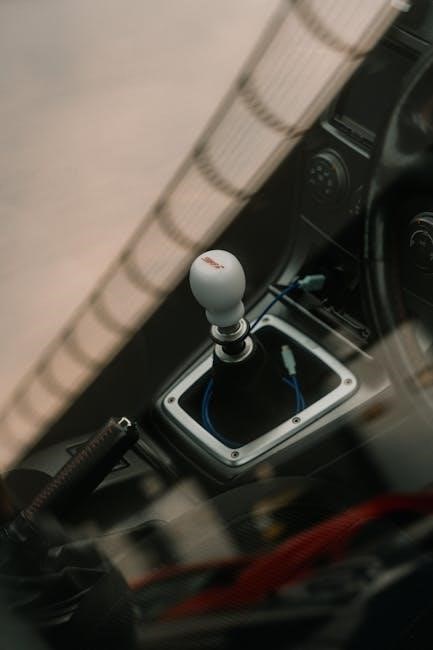
What Is a Manual Transmission?
A manual transmission‚ also known as a stick shift‚ requires the driver to manually change gears using a clutch pedal and gearshift‚ offering direct control and a mechanical driving experience.
Definition and Operation
A manual transmission is a type of gearbox that requires the driver to manually change gears using a clutch pedal and a gearshift. The clutch pedal disengages the engine from the transmission‚ allowing the driver to shift gears smoothly. The gearshift‚ typically located on the center console or floor‚ is used to select the desired gear ratio. Manual transmissions rely on synchromesh technology to synchronize gear speeds during shifts‚ ensuring smooth transitions. This system provides direct control over the vehicle’s power delivery and torque‚ enabling drivers to tailor acceleration and deceleration to their driving style and road conditions.
Benefits of Manual Transmissions
Manual transmissions offer several advantages‚ including enhanced driver engagement and control. They provide a direct connection to the vehicle‚ allowing drivers to optimize gear shifts for better performance and fuel efficiency. Manuals are often more reliable and durable due to fewer electronic components‚ reducing maintenance costs. They also tend to be lighter‚ improving power-to-weight ratios and handling. For enthusiasts‚ the tactile experience of shifting gears manually is irreplaceable‚ making driving more immersive and rewarding. Additionally‚ manual transmissions are typically more affordable than paddle-shifted options‚ making them a cost-effective choice for many drivers seeking a more authentic driving experience.
Performance Comparison
Paddle shifters deliver rapid‚ hands-on-the-wheel gear changes‚ ideal for high-performance driving‚ while manual transmissions offer precise control and a tactile connection‚ appealing to driving purists.
Speed and Responsiveness
Paddle shifters excel in speed‚ enabling lightning-fast gear changes (around 0.25 seconds) without taking hands off the wheel‚ ideal for high-performance driving. Manual transmissions‚ while slightly slower (0.4 seconds per shift)‚ offer precise control and a direct connection to the vehicle‚ allowing drivers to optimize acceleration and responsiveness based on their driving style. Paddle shifters often include advanced features like rev-matching and automatic downshifting‚ enhancing smoothness and performance. Manual transmissions‚ however‚ provide a more tactile experience‚ with drivers feeling each gear engagement. The choice between the two ultimately depends on whether speed and convenience or control and driver engagement are prioritized.
Driver Engagement and Control
Manual transmissions offer unparalleled driver engagement‚ requiring active participation with the clutch and gearstick‚ which fosters a direct connection to the vehicle. This tactile interaction allows drivers to precisely control gear changes‚ optimizing acceleration and responsiveness. Paddle shifters‚ while convenient‚ reduce physical engagement‚ as gear changes are handled electronically. However‚ they keep hands on the wheel‚ enhancing stability during dynamic driving. For purists‚ manuals provide a more immersive experience‚ while paddle shifters appeal to those seeking ease without sacrificing performance. The choice reflects whether a driver values mechanical feedback and control or prefers a more streamlined‚ modern driving experience.
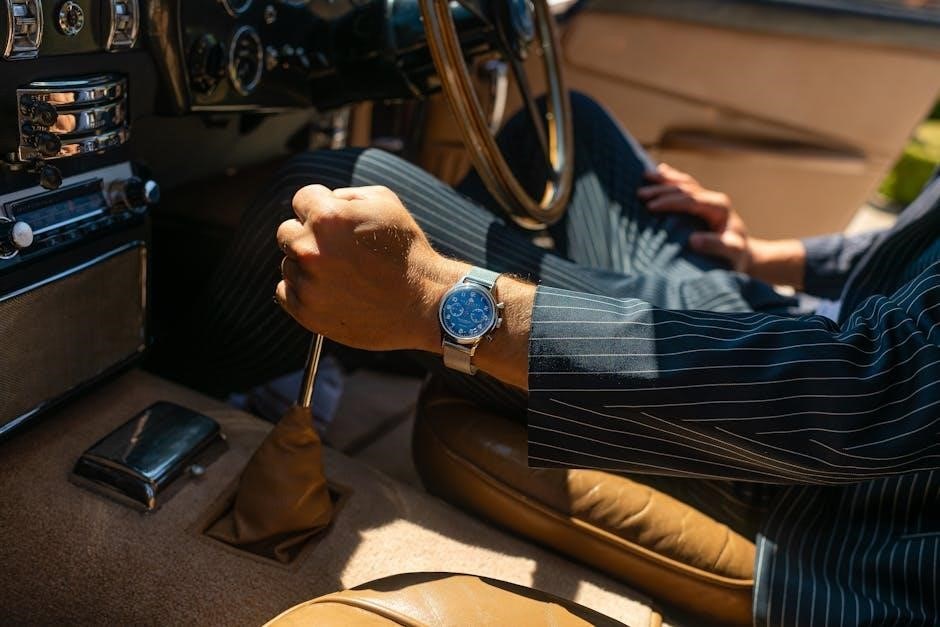
Convenience and Ease of Use
Paddle shifters offer unmatched convenience‚ allowing drivers to keep hands on the wheel during gear changes‚ ideal for city driving or high-performance scenarios. Manual transmissions‚ while less convenient in heavy traffic‚ provide a more engaging experience for enthusiasts.
Paddle Shifters in Daily Driving
Paddle shifters excel in daily driving by offering effortless gear changes without removing hands from the wheel‚ enhancing convenience and safety in city traffic. Their quick responsiveness makes navigating tight corners and sudden acceleration smoother. Ideal for urban environments‚ paddle shifters reduce driver fatigue during stop-and-go conditions. Additionally‚ they often include automatic modes for low-speed driving‚ making them versatile for both commuting and performance scenarios. This blend of modern technology and practicality ensures paddle shifters are well-suited for drivers seeking a balance between ease of use and dynamic driving experiences.
Manual Transmissions in Urban Environments
Manual transmissions in urban environments offer a unique driving experience‚ combining control and engagement. Frequent gear changes in stop-and-go traffic demand more driver involvement but provide a satisfying tactile connection. While paddle shifters are often more convenient‚ manuals allow precise control over acceleration and deceleration‚ which can be advantageous in tight city spaces. However‚ the constant use of the clutch and gear lever can increase driver fatigue in heavy traffic. Despite this‚ many enthusiasts appreciate the immersive experience and connection to the vehicle that manuals provide‚ making them a rewarding choice for city driving when skill and patience are applied.
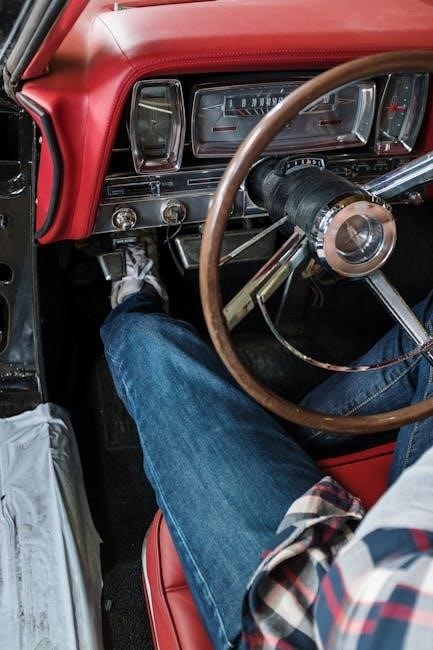
Cost Considerations
Paddle shifters are often more expensive‚ commonly found in luxury or high-performance vehicles‚ while manual transmissions are generally more affordable and accessible across various car models.
Price Differences Between Paddle Shifters and Manual Transmissions
Paddle shifters are typically more expensive than manual transmissions‚ as they are often part of advanced dual-clutch or automatic systems found in luxury and high-performance vehicles. Manual transmissions‚ on the other hand‚ are generally more affordable and widely available in a variety of car models. The cost difference is also influenced by the technology integrated into paddle shifters‚ such as automatic downshifting and rev-matching features‚ which add to their premium pricing. Additionally‚ vehicles equipped with paddle shifters often come with other high-end features‚ further increasing their overall cost compared to manual transmission options.
Long-Term Maintenance Costs
Paddle shifters generally have higher long-term maintenance costs due to their complex electronic and mechanical components. Repairs for dual-clutch systems or advanced transmission controls can be expensive. Manual transmissions‚ while requiring periodic clutch replacements‚ tend to be more cost-effective in the long run. Their simpler design means fewer components to fail‚ resulting in lower overall maintenance expenses. Additionally‚ manual transmissions are often more durable and less prone to costly repairs compared to paddle shifter systems. Over time‚ manual transmissions typically offer greater financial savings for drivers‚ making them a practical choice for those prioritizing affordability and reliability.

Real-World Examples
Cars like the Ferrari 488 GTB showcase paddle shifters‚ while the Porsche 911 GT3 RS highlights manual transmissions‚ each catering to distinct driver preferences and performance needs.
Cars with Paddle Shifters
Cars like the Ferrari 488 GTB and Lamborghini Huracán feature paddle shifters‚ offering rapid gear changes and seamless control. These systems are often paired with dual-clutch transmissions‚ enabling quick shifts without losing power. Paddle shifters are ideal for high-performance driving‚ allowing drivers to keep their hands on the wheel. Audi R8 and Porsche 911 models also utilize paddle shifters‚ combining efficiency with driver engagement. These cars demonstrate how paddle shifters enhance driving dynamics‚ especially in sporty or track-focused vehicles‚ making them a popular choice for enthusiasts seeking modern convenience and speed.
Cars with Manual Transmissions
Cars such as the Porsche 911 GT3 RS and Mazda MX-5 Miata are known for their manual transmissions‚ offering a tactile and engaging driving experience. These vehicles cater to purists who value direct control and mechanical connection. The Toyota GR 86 and Subaru BRZ also feature manual options‚ emphasizing precision and driver involvement. Manual transmissions are often preferred in lightweight‚ rear-wheel-drive cars‚ where they enhance the connection between driver and road. These models highlight the enduring appeal of manual transmissions for enthusiasts seeking a more immersive and skill-based driving experience.
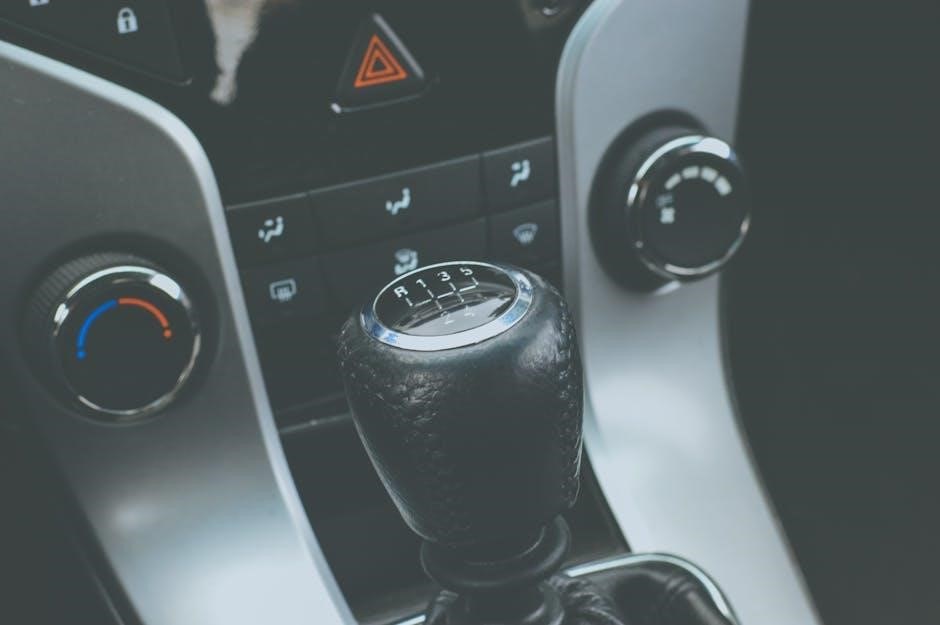
Driver Tips and Tricks
Master both systems by practicing smooth shifts and anticipating gear changes. Use rev-matching for manual downshifts and adapt your style for paddle shifters in high-performance scenarios.
Mastering Paddle Shifters
Mastering paddle shifters requires practice and a deep understanding of their functionality. Start by familiarizing yourself with the paddle controls‚ ensuring smooth and precise gear changes. Use rev-matching during downshifts to maintain stability and reduce wear on the drivetrain. Avoid sudden or aggressive shifts‚ especially at high speeds‚ to maintain control. For optimal performance‚ anticipate turns and downshift before braking to utilize engine braking effectively. Practice in low-traffic areas to build muscle memory and confidence. Regularly review your driving style and adjust your shifting technique to maximize efficiency and responsiveness. Consistent practice will help you fully harness the potential of paddle shifters.
Perfecting Manual Transmission Skills
Mastering a manual transmission requires patience‚ coordination‚ and consistent practice. Start by familiarizing yourself with the clutch and gearshift‚ understanding their feel and resistance. Practice in a safe‚ open area‚ such as an empty parking lot‚ to develop smooth clutch engagement and seamless gear transitions. Focus on coordinating the clutch pedal with the accelerator‚ especially when shifting between gears. Heel-toe downshifting is an advanced technique that improves control during braking by matching engine speed to gear speed. Regular practice helps build muscle memory and precision. Over time‚ you’ll develop a deeper connection with your vehicle‚ enhancing your driving experience and control. Consistency is key to mastering manual transmission skills.
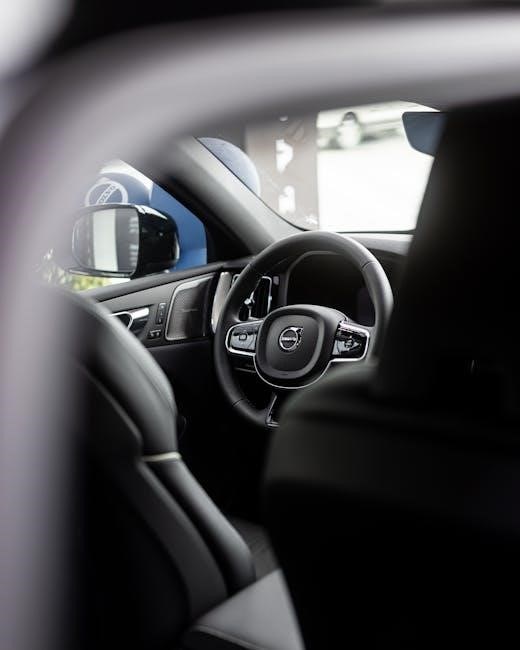
Common Misconceptions
Many believe paddle shifters are only for automatics‚ but they can pair with manuals. Others think manuals are outdated‚ yet enthusiasts value their tactile engagement and control.
Myths About Paddle Shifters
A common myth is that paddle shifters are only for automatic transmissions‚ but they can also be used with manual or dual-clutch setups. Another misconception is that paddle shifters lack engagement‚ though this varies by driver preference. Some believe paddle shifters are less reliable due to electronic components‚ yet they are often durable and require minimal maintenance. Additionally‚ many think paddle shifters are solely for performance driving‚ but they also enhance convenience in city driving. These myths highlight misunderstandings about their versatility and practicality‚ as paddle shifters blend modern technology with driving ease.
Myths About Manual Transmissions
One myth is that manual transmissions are outdated and less efficient‚ but they remain popular for their tactile driving experience. Another misconception is that manuals are difficult to learn‚ though most drivers master them quickly. Some believe manuals are less reliable than paddle shifters‚ yet they often have fewer electronic components‚ making them more durable. Additionally‚ the notion that manuals are only for performance vehicles is untrue‚ as they suit various driving scenarios. These myths overlook the unique benefits manuals offer‚ such as driver engagement and control‚ making them a preferred choice for many enthusiasts seeking a more connected driving experience.

Maintenance and Reliability
Paddle shifters and manual transmissions differ in reliability and maintenance needs. Manuals are often more durable with fewer electronic components‚ while paddle systems may require costlier repairs due to their complexity.
Durability of Paddle Shifters
Paddle shifters are generally less reliable than manual transmissions due to their reliance on electronic components and complex systems. Over time‚ the paddles and associated mechanisms can wear out‚ especially with frequent use. However‚ modern paddle shifter systems are built with durability in mind‚ incorporating high-quality materials and robust engineering. Regular maintenance is essential to ensure longevity‚ as failure to address issues can lead to costly repairs. Despite these considerations‚ paddle shifters remain a popular choice for drivers seeking convenience and performance‚ as they are designed to withstand the demands of both daily driving and spirited performance scenarios.
Reliability of Manual Transmissions
Manual transmissions are renowned for their durability and reliability compared to paddle shifters. With fewer electronic components‚ they are less prone to mechanical failure and require less complex maintenance. The simplicity of their design means that manual transmissions can withstand heavy use and harsh conditions without significant wear. Over time‚ components like the clutch and gear synchros may need replacement‚ but these are relatively affordable and straightforward to repair. This makes manual transmissions a cost-effective and dependable choice for drivers seeking long-term reliability. Their robust nature ensures consistent performance‚ making them a preferred option for both everyday driving and high-performance scenarios.
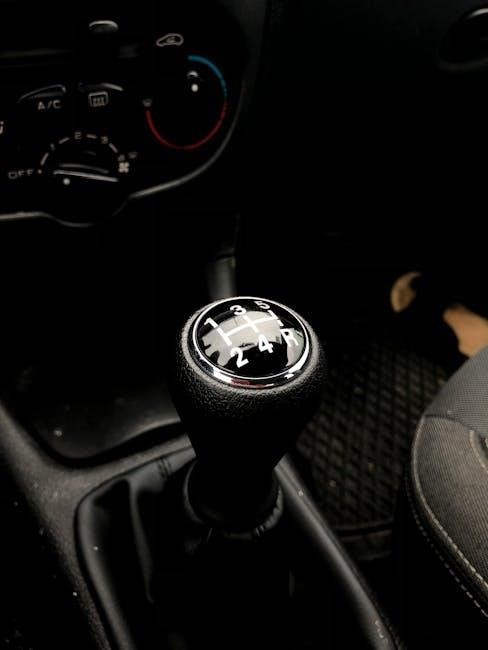
The Future of Transmissions
The future of transmissions leans toward hybrid and electric systems‚ blending paddle shifter convenience with manual transmission engagement‚ focusing on sustainability and performance optimization through advanced technology.
Advancements in Paddle Shifter Technology
Paddle shifter technology has evolved significantly‚ offering faster and more precise gear changes. Modern systems feature dual-clutch mechanisms and automated manual transmissions‚ reducing shift times and improving efficiency. Advanced driver-assistance features like rev-matching and automatic downshifting enhance performance and reduce wear on the drivetrain. Additionally‚ paddle shifters now integrate seamlessly with hybrid and electric powertrains‚ ensuring smooth transitions between power sources. These innovations make paddle shifters more accessible and user-friendly while maintaining their performance edge‚ catering to both casual and enthusiast drivers in an increasingly tech-driven automotive landscape.
Evolution of Manual Transmissions
Manual transmissions have seen steady improvements‚ focusing on enhancing driver engagement and mechanical efficiency. Modern manuals feature reduced weight‚ shorter throw lengths‚ and optimized gear ratios for better acceleration and fuel efficiency. Advanced materials and lubrication systems improve durability and reduce wear; Some models now incorporate automated rev-matching and downshifting capabilities‚ blending traditional control with modern convenience. Despite the rise of paddle shifters‚ manual transmissions remain popular for their tactile feedback and direct connection to the vehicle‚ appealing to purists who value the art of driving. These updates ensure manuals stay relevant in a competitive market‚ balancing tradition with innovation.
The choice between paddle shifters and manual transmissions balances modern convenience with traditional driver engagement‚ catering to individual preferences‚ driving styles‚ and specific automotive needs effectively.
Final Thoughts on Paddle Shifters vs Manual Transmissions
Ultimately‚ the decision between paddle shifters and manual transmissions depends on personal preference‚ driving style‚ and the intended use of the vehicle. Paddle shifters excel in convenience‚ offering rapid gear changes and ease of use‚ especially in high-performance or urban driving scenarios. Manual transmissions‚ on the other hand‚ provide a more tactile and engaging driving experience‚ appealing to purists who value control and connection with the vehicle. Both options have their strengths‚ and neither is inherently superior. By considering factors like performance needs‚ daily driving conditions‚ and individual skill levels‚ drivers can choose the transmission type that best aligns with their lifestyle and aspirations.
Recommendations Based on Driving Style
For performance-oriented drivers‚ paddle shifters are ideal due to their rapid gear changes and ease of use while keeping hands on the wheel. Those who value a more immersive experience and precise control may prefer manual transmissions. Urban drivers will appreciate the convenience of paddle shifters‚ especially in stop-and-go traffic‚ while casual drivers may find manuals more engaging. Track enthusiasts often favor manuals for their tactile feedback and ability to optimize gear selection. Ultimately‚ the choice should align with individual preferences‚ driving habits‚ and the specific demands of the vehicle. Balancing these factors ensures the best driving experience for any scenario.
